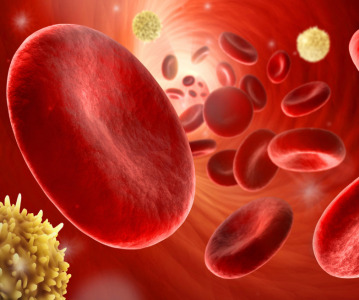Navitor Pharmaceuticals’ scientific founder makes landmark discovery of the molecular sensor for the amino acid leucine

Finding the long sought-after mediator of mTORC1 activation by leucine opens up opportunities for creating new medicines for metabolic, musculoskeletal, autoimmune and other age-related diseases.
Navitor Pharmaceuticals’ scientific founder, David M. Sabatini, has published ground-breaking research describing, for the first time, the identification and characterization of the cellular proteins responsible for sensing and mediating the metabolic effects of the amino acid leucine. The paper, published online in the journal Science, elucidates a key regulatory node related to leucine that was previously unknown within the multiple steps of the mTORC1 activation pathway.
The anabolic amino acid, leucine, is critical in cellular protein and lipid synthesis and directly regulates mammalian physiology including skeletal muscle growth, insulin secretion and food intake. As such, the ability to pharmacologically target the newly-discovered sensor for leucine opens a potential avenue for the modulation of mTORC1 to address healthspan and a range of diseases of aging including metabolic, neurodegenerative, autoimmune diseases, certain cancers, as well as age-related immune suppression and several genetic and rare diseases.
The discovery published in
“The discovery of this long sought-after mediator of mTORC1 activation by leucine opens up a novel and powerful approach to yield a new generation of drugs for multiple diseases of ageing. This is exactly aligned with Navitor’s approach to develop medicines that selectively target mTORC1 based on targeting critical cellular proteins involved in the activation of mTORC1 through nutrients such as amino acids and other components," said George P. Vlasuk, President and CEO of Navitor Pharmaceuticals.
“Leucine is one of the most physiologically important amino acids implicated in the regulation of mTORC1 activity; as such, it is a key driver of cellular growth and metabolism. This landmark discovery of the molecular sensor that links the availability of leucine to the activation status of mTORC1 in the cell facilitates a novel approach for the discovery and development of new drugs that can turn up or turn down mTORC1,” added Dr Vlasuk.
The mTORC1 molecular complex integrates multiple cellular signaling pathways in response to the availability of nutrients such as amino acids thereby serving as the primary central control point responsible for cellular growth and metabolism. The inhibition of mTORC1 has been demonstrated to address many diseases of ageing — including metabolic, neurodegenerative, autoimmune diseases, and certain cancers — as well as beneficially impacting healthspan leading to improved longevity in species as diverse as yeast to mice. In contrast, the reduced activity of mTORC1 is thought to play an important role in the atrophy of skeletal muscle associated with age (sarcopenia), immobilization and disease. Therefore, targeting cellular components involved in the regulation of mTORC1 activity that can yield both “inhibitors,” as well as “activators” of this complex offer a novel and powerful approach to the discovery and development of a new generation of drugs for the treatment of many diseases caused by the dysregulation of mTORC1.
Related News
-
News Google-backed start-up raises US$600 million to support AI drug discovery and design
London-based Isomorphic Labs, an AI-driven drug design and development start-up backed by Google’s AI research lab DeepMind, has raised US$600 million in its first external funding round by Thrive Capital. The funding will provide further power t... -
News AstraZeneca to invest US$2.5 billion in Beijing R&D centre
Amid investigations of former AstraZeneca China head Leon Wang in 2024, AstraZeneca have outlined plans to establish its sixth global strategic R&D centre in China. Their aim is to further advance life sciences in China with major research and manufact... -
News Experimental drug for managing aortic valve stenosis shows promise
The new small molecule drug ataciguat is garnering attention for its potential to manage aortic valve stenosis, which may prevent the need for surgery and significantly improve patient experience. -
News How GLP-1 agonists are reshaping drug delivery innovations
GLP-1 agonist drug products like Ozempic, Wegovy, and Mounjaro have taken the healthcare industry by storm in recent years. Originally conceived as treatment for Type 2 diabetes, the weight-loss effects of these products have taken on unprecedented int... -
News A Day in the Life of a Start-Up Founder and CEO
At CPHI we work to support Start-Up companies in the pharmaceutical industry and recognise the expertise and innovative angles they bring to the field. Through our Start-Up Programme we have gotten to know some of these leaders, and in this Day in the ... -
News Biopharmaceutical manufacturing boost part of new UK government budget
In their national budget announced by the UK Labour Party, biopharmaceutical production and manufacturing are set to receive a significant boost in capital grants through the Life Sciences Innovative Manufacturing Fund (LSIMF). -
News CPHI Podcast Series: The power of proteins in antibody drug development
In the latest episode of the CPHI Podcast Series, Lucy Chard is joined by Thomas Cornell from Abzena to discuss protein engineering for drug design and development. -
News Amgen sues Samsung biologics unit over biosimilar for bone disease
Samsung Bioepis, the biologics unit of Samsung, has been issued a lawsuit brought forth by Amgen over proposed biosimilars of Amgen’s bone drugs Prolia and Xgeva.
Recently Visited
Position your company at the heart of the global Pharma industry with a CPHI Online membership
-
Your products and solutions visible to thousands of visitors within the largest Pharma marketplace
-
Generate high-quality, engaged leads for your business, all year round
-
Promote your business as the industry’s thought-leader by hosting your reports, brochures and videos within your profile
-
Your company’s profile boosted at all participating CPHI events
-
An easy-to-use platform with a detailed dashboard showing your leads and performance







.png)






